Listen:
Check out all episodes on the My Favorite Mistake main page.
Joining me for Episode #30 of “the My Favorite Mistake” podcast is Katie Anderson, the author of the book Learning to Lead, Leading to Learn: Lessons from Toyota Leader Isao Yoshino on a Lifetime of Continuous Learning. We are also joined by Mr. Yoshino, the book's subject, who joined us from Japan.
You can download a sample chapter via Katie's website.
I get the very unique opportunity to ask each of them about their “favorite mistake.” Mr. Yoshino tells a story from his early days at Toyota, where he learned the importance of not blaming individuals for systemic problems. He later retired from Toyota after nearly 40 years of work in Japan and the United States.
Katie then tells a story, from early in her career, about being a “bull in a china shop” during meetings and getting feedback that caused her to reflect and change.
We then talk about lessons from Toyota and their book, including the importance of creating a culture where it's safe for people to speak up about mistakes — either in a factory or in a hospital. Why is it important for leaders to create the conditions for people to be successful? Why should leaders take responsibility when mistakes happen? Why is intentional reflection the key to learning?
I think you'll enjoy the conversation, as I did.
Watch the Full Episode:
Quotes:
!["[They could] easily blame me for the big mistake, but they didn't. So what is the thinking behind this? It is because they want to solve the problem because we are not perfect."](https://www.markgraban.com/wp-content/uploads/2021/01/My-Favorite-Mistake-Yoshino-Quote.jpg)
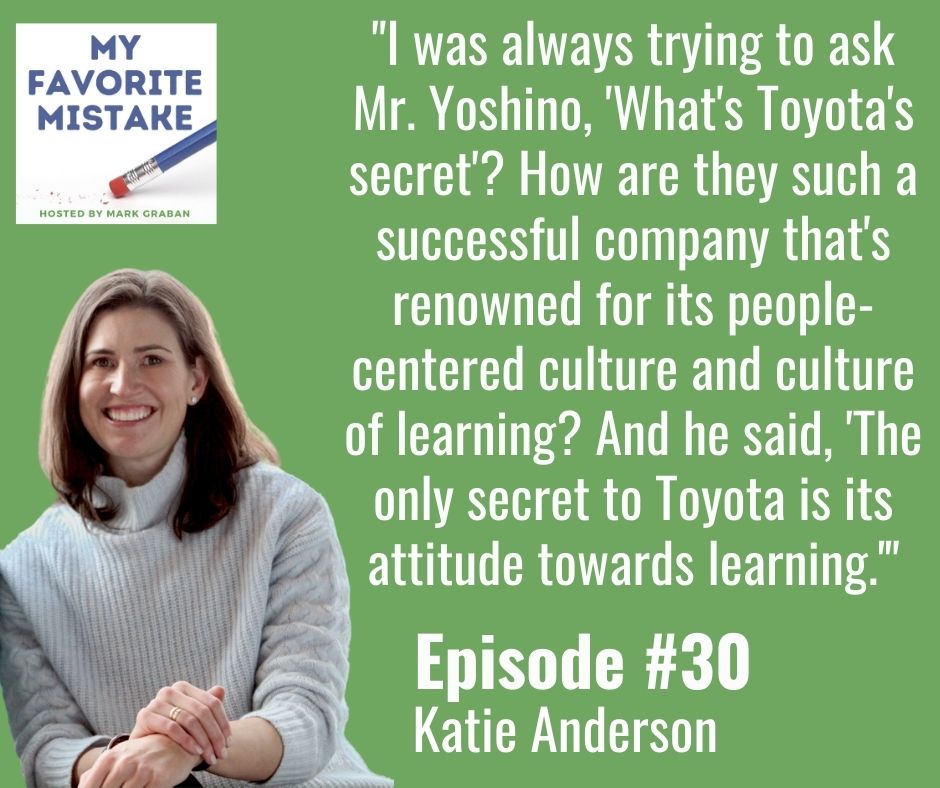
Subscribe, Follow, Support, Rate, and Review!
Please follow, rate, and review via Apple Podcasts or Podchaser or your favorite app — that helps others find this content and you'll be sure to get future episodes as they are released weekly. You can also become a financial supporter of the show through Anchor.fm.
You can now sign up to get new episodes via email, to make sure you don't miss an episode.
This podcast is part of the Lean Communicators network.

Other Ways to Subscribe or Follow — Apps & Email
Isao Yoshino & Katie Anderson On Mistakes, Leadership, Learning, And Culture
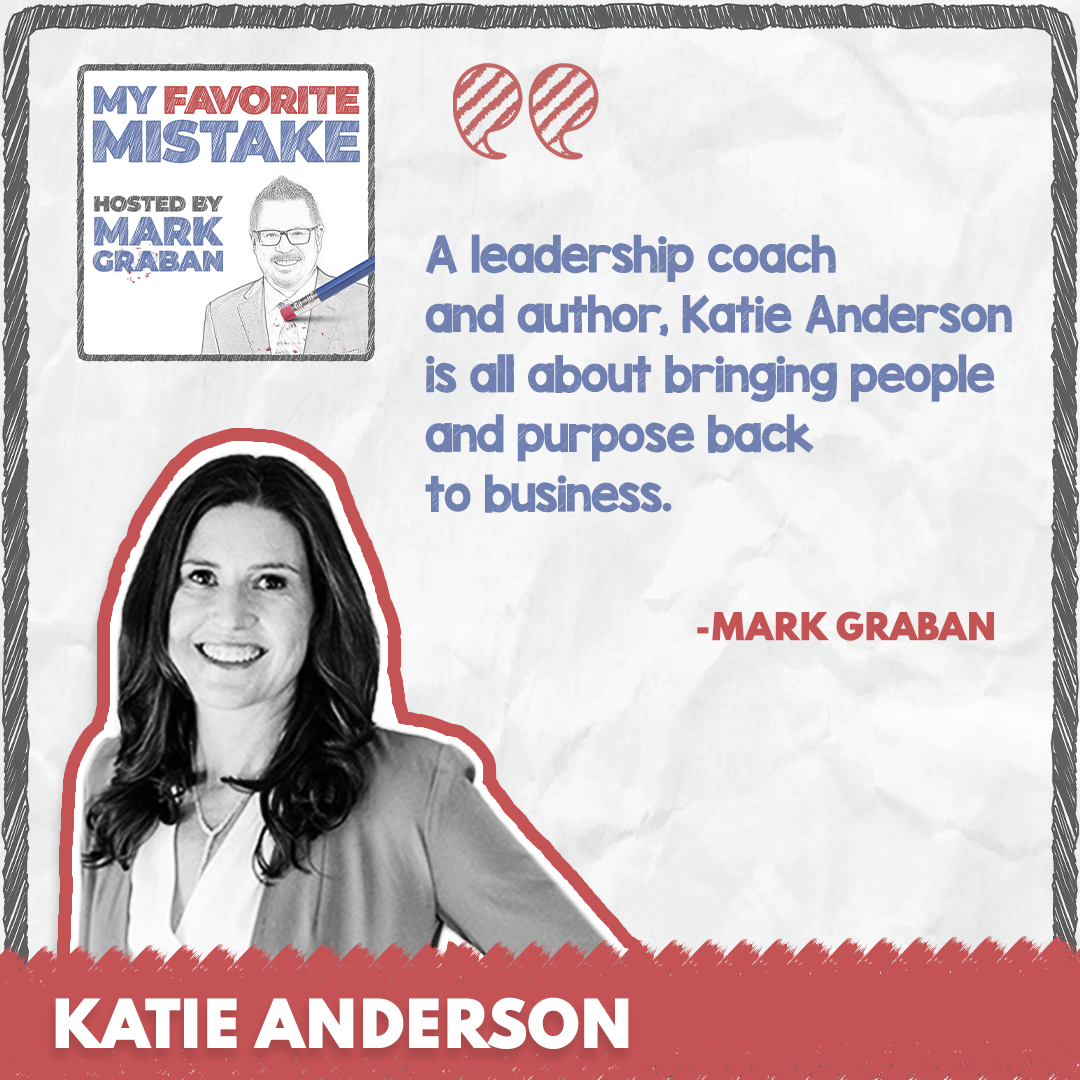
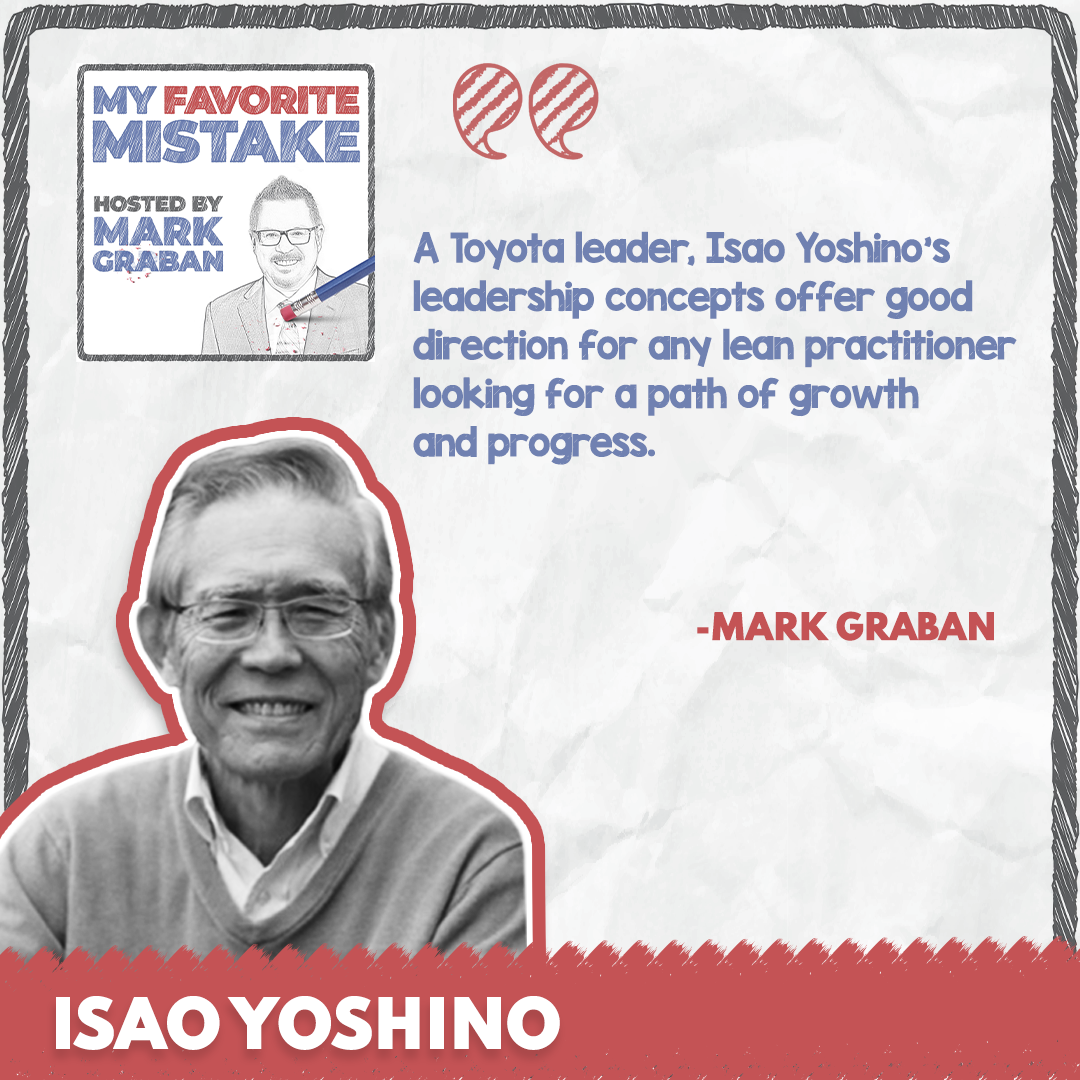
I'm excited to be joined by two guests who are both very special people to me. I'll introduce them and we'll know a little bit about their connection and collaborations. We have a great conversation. My guests are Katie Anderson and Isao Yoshino. Katie is the author of a book titled Learning to Lead, Leading to Learn: Lessons from Toyota Leader Isao Yoshino on a Lifetime of Continuous Learning. This book is a collaboration. Katie is a leadership coach and published author. Her firm is KBJ Anderson and you can find her at KBJAnderson.com. Katie and I have known each other for decades.
It was back when I was at Stanford Children's Hospital many years ago.
We have a lot of professional connections. Mr. Yoshino, I'm honored that you are here. I did my first study trip to Japan in 2012 and Mr. Yoshino gave a lecture. I had a chance to talk with him at dinner. He spent nearly 40 years at Toyota working in Japan and the United States. Mr. Yoshino, it's great to see you again. Thank you so much for joining us. How are you?
I'm fine, thank you.
You're coming to us from Japan.
South of Toyota City.
Okazaki City. It's about 20 miles South of Toyota City.
You are my first guest from Japan. It's an honor. Thank you for being here. We'll talk about the book. One of the themes from the book is learning from mistakes as we talk about all the time here on the show. Mr. Yoshino, do you have a story that you'd like to tell about something you consider to be a favorite mistake?
My biggest mistake is already in the book which Katie wrote. I've made so many mistakes in my entire life, big and small but the topic I'm going to talk about is almost the biggest one. It's a very interesting experience. I joined Toyota in 1966. We graduate from university to start working in April because school starts in April and ends in March. When we graduate from university in March, then we start working in April. Particularly in Toyota, the first four months for the newly hired people will go through the orientation. Each note that you go to a certain section and start working. We don't do that.
The first 4 months are long 4 months we go through the orientation. In the first month, maybe it's a classroom orientation about Toyota history and all those things. Based on that, we are sent to the plant because Toyota is a manufacturing company, where they are manufacturing cars. We work the same way as the worker over there for about 2 months total, 2 times. My story is about my experience working in that plant. I was assigned to Motomachi Plant where people are manufacturing small-size cars like Corona, not the virus.
That was the manufacturing plant. I was sent to the paint shop. It's not that I was painting the car body but I was sent to the preparation storage where we have some paint cans. We keep it and put it in the tank. The paint is brought into the painting shop. We have to prepare all those paintings. My job was to put the paint in the tank and also the solvent. At the time, we have to put in two different materials. One is the paint itself and the other is the solvent. We have to put to together.
Every 2 or 3 hours when the tank is empty, my job is to put paint A into the tank mixer, then the same material solvent A to the tank and then push the button. The machine mixes it up and then sends it through the pipe to the painting shop. That's my job. Maybe 2 or 3 hours later, then it gets empty so I have to do the same thing. One day, when I finish my work, I was waiting and taking a look at the document or something.
All of a sudden, these people in the painting shop rushed to our storage and asked me, “Something is wrong in the painting shop because the paint does not stick to the bottle panel.” The people came in and I was very new. It's my first week or so. I was so surprised, “Something is wrong. I must have done something wrong.” People keep asking me, “What did you do there?” “I put this paint A in the tank, then I put solvent A in the tank.” I take a close look at the label. It was solvent B. I am not supposed to put that different one but I did it. I did not notice that.
A couple of hours later, it came out. We found out that I put the wrong solvent in the tank, which creates a huge problem. More than 100 cars should be repainted. I was so shocked. What happened next is that they did not blame me for the mistakes. It was my mistake. Instead, they ask me, “How did it happen?” “I did what I was being told. However, I pick up the wrong one because there is no site defined somewhere. I pick it up from this corner and put it up but I pick up the wrong one.”
The big boss of my store said, “You pick up the wrong one but without noticing that. It's not necessarily your mistake. It's our mistake because we did not give you all the detailed instructions but we let you do that yourself. Don't worry. We have to figure out how to stop the same thing from happening again.” Nobody ever blames me. I was shocked at that. It makes me feel so happy. These guys did not start blaming me but they want to find the real cause of the problem. The paint manager also came in.
All of the people look at the problem and think of the same way how to solve the problem. After that, my boss and group leaders try to segregate the area where to store paint A and B. They learned some lessons from my big mistake. That was a big mistake for me because, at that time, I thought, “What kind of people are these people?” Usually, they can easily blame me for the big mistake but they didn't. What is their thinking behind this? Is it because they want to solve the problem because we are not perfect? We make mistakes. Mistakes happen everywhere, particularly to a newcomer like me. That is what happened to me.
[bctt tweet=”They could easily blame me for the big mistake, but they didn’t. So what is the thinking behind this? It is because they want to solve the problem because we are not perfect.” via=”no”]
After that experience, I talk about my mistake with my colleague. We joined the same company at the same time. I talk with a friend, “This is the mistake I made. What do you think?” “Don't worry. I did a similar thing in my stamping shop or another part of the location.” For several people, these are the same mistakes because we are new but they received the same reaction as I received this. It was an amazing experience for me.
I tried to learn what is the concept behind their attitude. You cannot get anything out of blaming somebody but you can get an important lesson you can learn from the mistakes some people make by discussing everything and going to the real cause of the problem. That is the core thing that they believe is so important. In the first stage, I get that experience. I learned, “This is one of the very important cultures that Toyota carries.” I was so proud of being part of Toyota in a few weeks but still, it was a great experience for me. That's why I wanted to share this with your people.
That's such a powerful thing to learn early in your career. Some people do not get that opportunity. They get blamed for something, whether they were involved or not. This is where people learn to blame coworkers or hide and cover up problems. That's what prevents learning and improvement.
I remember when we were first starting to work on the book and decided to start at the very beginning of Mr. Yoshino’s career. Mr. Yoshino, I remember you laughing as you recalled this memory that you hadn't thought of in years and how foundational it was for your experience of learning to be a learner and a leader at Toyota. What a powerful story, what a great mistake and the responsive leaders as well.
I've never worked at Toyota but I've gotten to know many people who did work at Toyota. I've pulled up one page from the book Learning To Lead, Leading To Learn that says, “Lesson number two, create the conditions for people to be successful.” I've heard that same idea, slightly different words from different former Toyota people. One of those people, Darryl Wilburn, who worked in the United States and Kentucky and San Antonio, I've heard him say, “It's a leader's responsibility to create a system in which people can be successful.” To me, that's a sign that a culture is very strong when decades later on a different continent, that same idea is still there within Toyota.
We'll dive into this later on how this concept of mistakes, failure and embracing failure as a source of learning was so much of a part of Mr. Yoshino’s years at Toyota as well.

Katie, do you have a story that you want to tell about your favorite mistake?
I do. It took me a little while to think about what story I was going to tell because we all have many mistakes. Before we started the show, we were even talking about all the little mistakes that many of us had made. When I was thinking about for myself what my favorite mistake was, I wanted to frame it on something that I had learned the most from and what had been the most impactful for me. That has to go to a mistake that I have made many times. The story I'm going to tell is the time that this mistake first revealed itself to me and how it started me on my path of continuous improvement to be a better leader and coach.
I was in my mid-twenties. I was in a place of a career transition. I was living in Australia where I received my Master's degree and had been awarded a prestigious academic scholarship. I had been for years rewarded for being the expert problem solver and the expert person. Sharing my opinion was what I was supposed to do. I made a decision to leave academia and take a consulting role at a consulting firm in Australia where I lived for four years.
Paint the picture. I'm in a room with other colleagues at various levels within the firm. This is not a client-facing meeting but this is a team meeting of different consultants. I was jumping in and offering my opinion and idea. I remember even this is a visceral feeling I have of wanting to jump in and be part of it and my energy. After that meeting, one of the partners came up to me. The way she delivered the feedback was perhaps not the best. I always welcomed feedback but the words she used didn't necessarily resonate with me at the time.
I debated whether or not I was going to say this on the show because they frustrated me at the time. These words, in retrospect, help galvanize me to realize there was something that I needed to change the mistake that I was making. She said I was like a bull in a China shop, barely my way through a meeting to get my opinion out. It took me a while to accept that. I heard her but I didn't take that on for many years.
That was the beginning of my realization that I needed to make a shift for myself. I was no longer in a purely expert role but I also was in a role where I was working with people. I was helping to develop people and collaborate with people. I continued to make the same mistake over and over again. Probably not as, egregiously. From that point, I moved back to the United States and took on a role, which is where you and I met Mark at Stanford Children's Hospital in a continuous improvement, internal consulting role. I realized through my six years at Stanford Children's that I needed to shift from being the expert, always telling my ideas and coming up with the solution and offering my opinion to being more of a coach.
I took a more senior leadership role at the Palo Alto Medical Foundation, leading a team of continuous improvement coaches and consultants and working at the executive level. I had an external coach who worked with me. She was the one who was the real catalyst for me to take some steps back and reconnect and identify what was my purpose, what was the intention of my role and what behaviors aligned with that.
It was that year that I made some transformational changes for myself about not jumping in and always giving my opinion. It wasn't about me being right. It wasn't about my ideas. Sometimes it was but more often than not, it was about me taking a step back and listening, asking questions and helping other people develop.

This has become my passion in my career. What I see is something that I can help people with is making that transition from being an expert or being the one who has the answers, being in a people development role and how we successfully navigate that transition. Know that sometimes we navigate that through each day. Sometimes we are the problem owner or need to be the expert but many times, we should be showing up. It's less about what us being right and more about how can we help support someone else being right. I hate the phrase, “Bull in a China shop,” but it does if you think back to me many years ago. That was the real beginning of realizing that I was making mistakes, how I wanted to show up and be in the world.
Who was it that the feedback came from specifically? Was it a peer or the leader?
It was one of the partners I was working with. It was another woman who was one of the few women partners at the firm who gave me that feedback.
I was wondering if gender and expectations played any role in that in terms of behaviors and aggressiveness.
That was one of the reasons I initially and still bristle a little bit because I did have the experience that there may have been some gender expectations in there too that it was more okay for men to be speaking up. There were more men at the time. I was an American woman in an Australian cultural environment at that time. I do believe some of that played a role, which is part of the reason I wasn't sure if I wanted to share that story.
At the end of the day, when I look back on it, that was the beginning of me starting to see that I was making a mistake in how I was showing up if I wanted to be effective in a team environment, working with people and connecting with my purpose, which was to help other people move forward. There were some things about that at the beginning of my l realization of the mistake and how I was showing up.
People often say, “Feedback is a gift but some feedback is more specific or helpful than other feedback.” In the book, one of the themes is, “Reflection as the key to learning.” If somebody throws a phrase at you like, “Katie, you're being a bull in a China shop,” it would be difficult to reflect on that feedback other than maybe some blunt reaction like, “I'll sit and be quiet.”
Thank you, Mark. You're validating my reaction to that feedback. There was important feedback to be had but the delivery and the method of that feedback were not effective. It could have been said in a more reflective way that would've been more helpful for me at that moment.
You continued to make that mistake. What was the gradual self-discovery over time perhaps in terms of finding the right balance of when to speak up, state something, ask a question or listen?
Some of it happened organically through my experience and then some of it happened with real intention. It was a realization that it wasn't sustainable. If I wanted to be helping this organization, create sustainable improvement and have the people who worked in the workplace have more capability and confidence of continuing to improve the processes we were working on, me going in and behind the scenes doing all the problem-solving wasn't achieving that outcome.
I had a role in teaching them and guiding them along the way. Me doing it all behind the scenes and being the expert who swishes away and leaves them with it wasn't helpful. It was when I had a coach who was working with me with purpose and intention, who was very good at asking those questions to help self-awareness. I'd gone on a journey from that time. To ask those questions, “Whom do you want to be? How do you want to be showing up? What outcomes do you want for your people and organization? What role do you have that you're acting in? How is that influencing those outcomes?”
It was putting purposeful practice. What I help other people work with is sometimes it's the process of some self-awareness. Once you're aware of how you're showing up, it's can be quite easy to make changes because you start being horrified like, “I interrupt people all the time.” My good friend Karyn Ross was laughing. She's like, “I would never have thought that you were an interrupter.” I'm like, “I still can be an interrupter,” but I work hard at not interrupting people and interjecting my opinion all the time, certainly to offer it but to do it more constructively and purposefully.
[bctt tweet=”Once you're aware of how you're showing up, it can be quite easy to make changes because you start being more refined.” via=”no”]
Karyn Ross was guest number three. It's an interesting contrast in the two stories from you Katie and Mr. Yoshino. As that page that I had pulled up from the book, also says in the header here, “Not just create the conditions for people to be successful but then in parenthesis and take responsibility when mistakes happen.” I heard from your story, Mr. Yoshino, that the group leader or others took responsibility for putting you in that position. Katie, it seems like in your situation, that partner wasn't taking responsibility for maybe not having proactively coached you or the firm not having better expectations. The mistake sounded straightforward to solve an A versus solvent B either.
She probably thought that she was helping create those conditions but her words maybe didn't help as much in the moment but they did spur me in retrospect. It was a wake-up call for me that others' experience of how I was showing up was not congruent with my experience of how I wanted to be seen and contribute. In that way, it was helpful.
Those are two stories for readers and myself to reflect on different leaders reacting to situations differently and how we try to create a culture as you write about in the book, where you're developing people, improving and succeeding as an organization. Before I wrap up, I do want to talk a little bit more and the story behind the book, Learning To Lead, Leading To Learn. I want to ask your reflections on the book but Katie, what led to this opportunity to write a book, collaborate with Mr. Yoshino and capture so much of what you've learned and what he's taught others?
Some of it was serendipity that I had the unique opportunity to move to Japan in 2015 for eighteen months with my family. It wasn't for my job. It was for my husband but as a lean practitioner and consultant, he is very interested in international experiences and also the Toyota production system which I was very thrilled with.
I met Mr. Yoshino six months before we moved to Japan. He gave me his card and said, “Look me up when you get down there and I'll take you to Toyota City. We'll do a tour of Toyota.” I made my husband take the day off of work. I thought it was going to be a once-in-a-lifetime opportunity. We had a wonderful day together, spending time talking. From that point forward I jumped on that Shinkansen, the bullet train and take the 90-minute journey down to see Mr. Yoshino many times. We continued our discussions and they evolved.
When I moved back to the US, we continued to talk. I believe it was Mr. Yoshino's idea. I started writing a blog when I moved to Japan and you were super helpful, Mark in helping me think about how to get that set up and some initial spreading the word about it. I was writing about my conversations with Mr. Yoshino. He was so generous saying, “Anything we talk about, you're welcome to write about on your blog.” People were interested in our conversations. We are back from Japan to the United States. We continued to talk and I was writing these blog posts.
Mr. Yoshino said, “Maybe we should work on a booklet together.” I was like, “It might be more than a booklet.” I had the inkling at that point that writing something more than a blog post was going to take some serious effort. We said, “Let's do a book.” We started with purposeful interviews and it evolved into a much bigger project than either of us had imagined. I'm so grateful for the experience of getting to work with Mr. Yoshino. I learned so much from him in the depth of reflection. If we go back to that concept of reflection that he was willing to undertake and share his lessons of success, failure, challenge and learning, it was tremendous. That was our journey together. One of the most important relationships in my adult life is with this man.
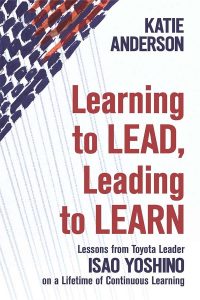
The book has gotten such a positive reception and the reviews that people can see on Amazon are very positive. Mr. Yoshino, how does it feel to have so many of your stories from your life? Talk about your goals as a child growing up. There's a lot about you in the book. How does that sound?
It was a very interesting experience to work together with Katie because this was the first time I met in my entire life that people keep asking me lots of questions about my life, childhood and eternal life. I've never received any of those questions from Japanese people. Every time Katie asks some simple question, it is so profound and has a deeper meaning. It's a very much good trigger for me to look back on my past. Most of the things I talk about and what she wrote in her book are what I start remembering when she asked me. I try my best to remember all those memories, which are already hidden somewhere. It's a very big trigger.
That is the power of asking effective questions to me. I learned so much from my experience one more time. I learned when I experienced something, then I learned something at the time. I relearn some important lessons from sharing my stories with Katie. It was a great experience for me. It's the power of asking effective questions. It means a lot to me. It's not my biography. It is a history of my series of learning. I appreciate that Katie gave me a chance to look back and relearn some lessons again. It's two times new learning. It's a great thing to do in my life.
Questions, reflections and learning are a lot better than blame and punishment.
I love the title and focus of this show. It resonates with so many of the stories in the book but stories from Mr. Yoshino’s life. The book or his experience at Toyota was bookended by these two different experiences. One was the story he shared on the show. The other was at the end of his career, which is a very significant, large business, venture that failed. Throughout all of that, the response of leaders was the same around mistakes and failure and failure as a source of learning and how even the president of Toyota, Mr. Cho had said to Mr. Yoshino after pretty challenging many years of working on this project, “We don't blame you for this business failure. We also had responsibility for this. You were new to the business. We were new to the business. We all have an opportunity for learning.”
I was always trying to ask Mr. Yoshino, “What's Toyota's secret? How are they such a successful company that's renowned for being people-centered culture and culture of learning?” He said, “The only secret to Toyota is its attitude toward learning.” That's about learning from mistakes as well as failure and looking at the process and not just the outcome. That's so critical for all of us to remember. There's a proverb that I learned in Japan about falling that says, “Fall 7 times, get up 8.”
[bctt tweet=”I was always trying to ask Mr. Yoshino, “What’s Toyota’s secret? How are they such a successful company that’s renowned for its people-centered culture and culture of learning?” He said, “The only secret to Toyota is its attitude towards learning.”” via=”no”]
These Japanese Daruma dolls represent that as well. It's about setting a goal with an intention. You fill in Daruma’s eye. This is from submitting our manuscript. I have my goal here. The expectation is you're not going to achieve something with success out of the gates. There are going to be mistakes and failures along the way. I do it in my hand. It's not very good but they're weighted at the bottom because when you fall, you need to get up. That perseverance, grit, tenacity and learning are how we're going to move toward success. Mistakes, struggle and failure are part of the learning journey toward success. If we can reframe mistakes and failure differently and have a different response, when people make mistakes, that's how we're all going to create a better world.
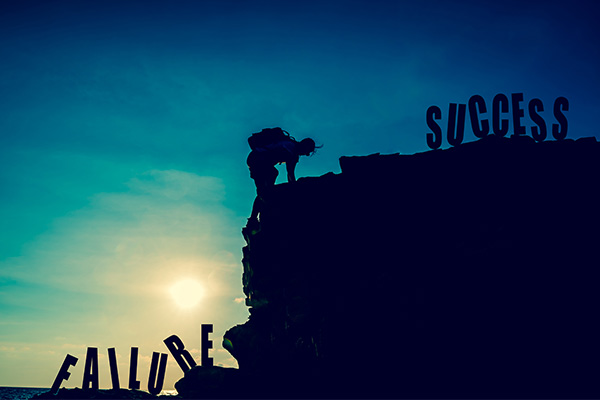
We're going to make your book the official book of the show because that is such a powerful theme and one of the threads through the book, Learning To Lead, Leading To Learn. Katie, there was an offer that you were going to mention, a downloadable sample from the book. Can you tell the audience about that?
I have a downloadable sample from the book if you haven't had the opportunity to read it, a chapter that describes Mr. Yoshino’s story that he talked about as well as some of the introductory parts of the book for you. You can go to KBJAnderson.com/My-Favorite-Mistake. We'll have some other specials coming forward. Check out that for some other announcements and opportunities for you to take advantage of.
This has been so nice to know your reflections and perspectives on learning from mistakes, both personally and some of the examples that we can get from Toyota. Mr. Yoshino, it's been a real honor to have you join us. Katie, as the author of the book, it’s the same. Thank you both for taking the time to be here. Arigato.
Thank you very much for having me.
It's been a pleasure.
Important Links
- Isao Yoshino
- Learning to Lead, Leading to Learn: Lessons from Toyota Leader Isao Yoshino on a Lifetime of Continuous Learning
- KBJAnderson.com
- Karyn Ross – Past Episode
- KBJAnderson.com/My-Favorite-Mistake
- Enter to win a free “My Favorite Mistake” coffee mug

